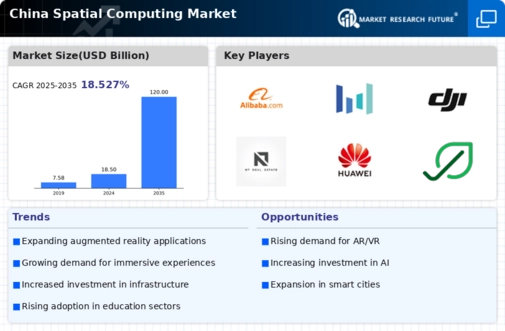Emergence of Smart Cities
The development of smart cities in China is creating new opportunities for the spatial computing market, as urban planners and developers seek innovative solutions to enhance city management and citizen engagement. Spatial computing technologies, such as AR and geospatial mapping, are being utilized to visualize urban data and improve decision-making processes. As cities become more interconnected, the demand for spatial computing applications that facilitate real-time data analysis and visualization is likely to grow. This trend aligns with China's broader goals of urbanization and sustainable development, suggesting that the spatial computing market will play a crucial role in shaping the future of urban living and infrastructure.
Expansion of 5G Infrastructure
The rollout of 5G technology in China is significantly impacting the spatial computing market by enabling faster data transmission and lower latency. This technological advancement facilitates the development and deployment of AR and VR applications that require real-time processing and high bandwidth. With 5G expected to cover over 90% of urban areas in China by 2025, the spatial computing market stands to benefit immensely from enhanced connectivity. The ability to stream high-quality content seamlessly will likely lead to increased adoption of spatial computing solutions in various industries, including gaming, healthcare, and manufacturing. As a result, businesses are likely to leverage 5G capabilities to create more interactive and responsive applications, further propelling market growth.
Rising Demand for Immersive Experiences
The spatial computing market is experiencing a notable surge in demand for immersive experiences across various sectors, including entertainment, education, and retail. As consumers increasingly seek engaging and interactive content, businesses are investing in augmented reality (AR) and virtual reality (VR) technologies to enhance user experiences. According to recent estimates, the market for AR and VR in China is projected to reach approximately $30 billion by 2025, reflecting a compound annual growth rate (CAGR) of around 30%. This growing appetite for immersive experiences is driving innovation and competition within the spatial computing market, prompting companies to develop more sophisticated applications and solutions that cater to consumer preferences.
Increased Focus on Education and Training
The spatial computing market is witnessing a growing emphasis on education and training applications, particularly in the context of remote learning and skill development. Educational institutions and corporate training programs are increasingly adopting AR and VR technologies to create immersive learning environments that enhance engagement and retention. Reports indicate that the use of spatial computing in education could improve learning outcomes by up to 40%. This trend is likely to drive investment in the spatial computing market as educational stakeholders recognize the potential of these technologies to transform traditional learning methodologies. Consequently, the market is expected to expand as more institutions integrate spatial computing solutions into their curricula.
Growing Investment in Research and Development
Investment in research and development (R&D) within the spatial computing market in China is on the rise, as companies and institutions strive to innovate and stay competitive. The Chinese government has been actively promoting R&D initiatives, providing funding and support for projects that advance spatial computing technologies. This focus on innovation is expected to lead to breakthroughs in areas such as computer vision, machine learning, and human-computer interaction. As a result, the spatial computing market is likely to benefit from a steady influx of new technologies and applications, enhancing its overall growth potential. The commitment to R&D may also attract foreign investment, further bolstering the market's development.

















Leave a Comment